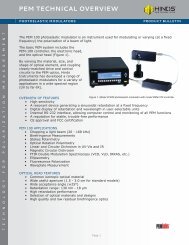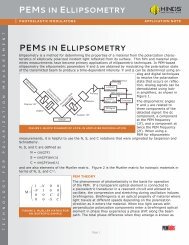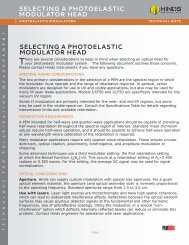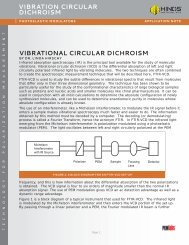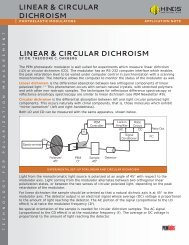Magnetism in a New Light - Hinds Instruments
Magnetism in a New Light - Hinds Instruments
Magnetism in a New Light - Hinds Instruments
You also want an ePaper? Increase the reach of your titles
YUMPU automatically turns print PDFs into web optimized ePapers that Google loves.
HINDS INSTRUMENTS, INC.<br />
APPLICATIONS<br />
NEWS FOR USERS<br />
OF PHOTOELASTIC PEMTM<br />
MODULATORS<br />
MAGNETO-OPTIC KERR EFFECT<br />
<strong>Magnetism</strong> <strong>in</strong> a <strong>New</strong> <strong>Light</strong><br />
ABOUT THE AUTHOR<br />
Prof. Ron Atk<strong>in</strong>son,<br />
Queen’s University<br />
Belfast, UK<br />
Professor Ron Atk<strong>in</strong>son is Head of the Condensed<br />
Matter Physics and Materials Science<br />
Division <strong>in</strong> the Physics Department at the<br />
Queen’s University of Belfast. He is also a<br />
Fellow of the Institute of Physics, a senior<br />
member of IEEE, and Honorary Visit<strong>in</strong>g<br />
Professor <strong>in</strong> the Department of Physics at the<br />
University of Salford. Professor Atk<strong>in</strong>son took<br />
up a lectureship <strong>in</strong> the School of Maths and<br />
Physics at Queen’s Belfast <strong>in</strong> 1973 and is<br />
leader of the Th<strong>in</strong> Film Magneto-Optics and<br />
Magnetics group and QUB-Director of the<br />
Northern Ireland Centre for Advanced<br />
Materials. He has 28 years experimental and<br />
theoretical experience <strong>in</strong> th<strong>in</strong> film optics,<br />
magneto-optics and magnetics of multilayered<br />
nanostructures.<br />
You may also learn more about Professor<br />
Atk<strong>in</strong>son and the magneto-optic Kerr effect by<br />
visit<strong>in</strong>g his website at<br />
http://wwwparent.qub.ac.uk/mp/con/<br />
magnetics_group/magnetoptics.html.<br />
FALL 2001<br />
by Professor Ron Atk<strong>in</strong>son, Queen’s University, Belfast, UK<br />
Introduction<br />
In 1845 Michael Faraday carried out a series of experiments to determ<strong>in</strong>e<br />
whether l<strong>in</strong>early polarised light, when passed through a transparent<br />
<strong>in</strong>sulator, was <strong>in</strong>fluenced by strong electric fields. Despite Faraday’s<br />
renowned experimental skills, he failed to observe any effects. Frustrated,<br />
he turned his attention to magnetic fields. Eventually, us<strong>in</strong>g quality optical<br />
glass that he had made himself some twenty years previously, he was able<br />
to detect a small magneto-optical change that became known as the<br />
1<br />
Faraday effect . Amaz<strong>in</strong>gly, 30 years later <strong>in</strong> 1875, the Rev. John Kerr, a close<br />
collaborator of William Thompson (later Lord Kelv<strong>in</strong>), repeated Faraday’s<br />
quest to demonstrate that electric fields can <strong>in</strong>fluence the polarisation state<br />
of optical radiation as it passes though a transparent material. It is a tribute<br />
to the keen experimental skills of Kerr that, where Faraday had failed, he<br />
was successful. Us<strong>in</strong>g a variety of materials, <strong>in</strong>clud<strong>in</strong>g glass and later a<br />
number of liquids, he demonstrated the electro-optic effect. In the<br />
follow<strong>in</strong>g year on the 26th August 1876, at the annual meet<strong>in</strong>g of the<br />
British Association for the Advancement of Science held <strong>in</strong> Glasgow, the<br />
Rev. John Kerr announced a further discovery of an effect that has s<strong>in</strong>ce<br />
2<br />
become known as the Kerr magneto-optic effect . Us<strong>in</strong>g l<strong>in</strong>early polarised<br />
light from a narrow paraff<strong>in</strong> flame, Kerr showed that a change <strong>in</strong><br />
polarisation state occurred on reflection from a polished, soft iron polepiece<br />
of a strong electromagnet (Figure 1). (cont<strong>in</strong>ued on page 2)<br />
Exicor ® W<strong>in</strong>s the 2001 R&D 100 Award<br />
June 29, 2001, H<strong>in</strong>ds <strong>Instruments</strong> was notified that Exicor had been<br />
selected as one of the 100 most technologically significant products of the<br />
year. Through the comb<strong>in</strong>ed effort and talented contributions of many<br />
H<strong>in</strong>ds employees, Exicor won the prized R&D 100 Award for the development<br />
of the technological <strong>in</strong>novation used <strong>in</strong> our birefr<strong>in</strong>gence measurement<br />
systems.<br />
Now <strong>in</strong> its 39th year, the R&D 100 Award program is <strong>in</strong>ternational <strong>in</strong><br />
scope. Entries from the most prestigious companies, national laboratories,<br />
research organizations and universities are received then nom<strong>in</strong>ated <strong>in</strong><br />
open competition. The news media refers to (cont<strong>in</strong>ued on page 4)
(cont<strong>in</strong>ued from page 1)<br />
Given that the changes produced by this effect are usually<br />
very small (< 0.1deg) and are difficult to observe, even with<br />
modern laser sources, the achievement of Kerr was spectacular.<br />
It is sober<strong>in</strong>g to realise that the effects discovered over<br />
125 years ago by Kerr now form the basis of a substantial<br />
magneto-optic record<strong>in</strong>g <strong>in</strong>dustry.<br />
With<strong>in</strong> the Physics Department at the Queen’s University<br />
of Belfast the work of Kerr cont<strong>in</strong>ues, where l<strong>in</strong>ear first-order<br />
magneto-optical effects are be<strong>in</strong>g used to study the magnetic<br />
properties of s<strong>in</strong>gle and multiple layer materials. To<br />
make observations of Kerr magneto-optical effects on bulk<br />
samples is difficult enough. To do so at the atomic level,<br />
without modern light sources and optical modulation techniques,<br />
would be virtually impossible. However, it is the<br />
particular technological advantages, robustness and convenience<br />
of the Photoelastic Modulator (PEM) system that<br />
makes it possible to detect magneto-optical signals produced<br />
by sub-atomic magnetic layers relatively easily.<br />
Operational Pr<strong>in</strong>ciples<br />
The polar Kerr effect is illustrated phenomenologically <strong>in</strong><br />
Figure 2, where l<strong>in</strong>early polarised light is <strong>in</strong>cident normally<br />
(or obliquely) on a sample that may be magnetised ( M)<br />
<strong>in</strong> a<br />
direction perpendicular to the surface. After reflection, <strong>in</strong><br />
addition to the usual Fresnel amplitude component r,<br />
a small<br />
orthogonal Kerr component k appears that, <strong>in</strong> comb<strong>in</strong>ation<br />
with r,<br />
leads to elliptically polarised light with a complex Kerr<br />
rotation θk and ellipticity εk given by θk+<br />
iεk ≈ kr /
photoelastic modulation technique is that fundamental ( )<br />
and second harmonic ( 2ω)<br />
signals are generated that are<br />
directly proportional to the Kerr ellipticity and rotation, respectively.<br />
Furthermore, the normalisation of these signals<br />
with respect to the measured dc level serves to reduce the<br />
effects of fluctuations <strong>in</strong> source <strong>in</strong>tensity. Us<strong>in</strong>g lock-<strong>in</strong><br />
amplifiers tuned to each frequency, and follow<strong>in</strong>g simple<br />
calibration procedures, the Kerr effect can be fully characterised<br />
dynamically <strong>in</strong> real-time and with considerable<br />
speed and sensitivity. In the case described below, the<br />
precision was typically of the order of 1 arc sec with an<br />
<strong>in</strong>strumental time constant of 100 ms. However, this was<br />
limited by the mechanical stability of the experimental<br />
system rather than shot-noise or laser <strong>in</strong>stabilities.<br />
In situ dynamic studies of film growth.<br />
With this level of <strong>in</strong>strumental sensitivity, the team at<br />
Queen's has followed the growth dynamics of multiple<br />
layers of materials such as Co-Pt, Co-Pd, and Co-Au, etc.,<br />
that have potential for next generation magneto-optic<br />
<strong>in</strong>formation storage. Both <strong>in</strong> situ ellipsometry and Kerr<br />
polarimetry have been used to monitor the evolution of the<br />
physical properties of various layers <strong>in</strong> real-time as films are<br />
grown, layer-by-layer, <strong>in</strong> a sputter deposition vacuum<br />
chamber (Figure 3). The results of such experiments give<br />
tremendous <strong>in</strong>sight <strong>in</strong>to both the way <strong>in</strong> which material<br />
properties develop, as well as fundamentally new phenomena.<br />
The data that is produced, if obta<strong>in</strong>ed comprehensively,<br />
may be used to optimise the geometrical structure of<br />
the media <strong>in</strong> order to br<strong>in</strong>g out the maximum potential for<br />
applications <strong>in</strong> magneto-optic read-out.<br />
D<br />
PC<br />
PC<br />
HeNe<br />
A<br />
PEM<br />
LA-1<br />
LA-2<br />
P<br />
M<br />
M<br />
D<br />
Figure. 3.<br />
Schematic diagram of the deposition system.<br />
HeNe: helium neon laser, A: analyser, P: polariser,<br />
RA: rotat<strong>in</strong>g analyser, PEM: photoelastic modulator, M: magnetron,<br />
PC: computer, S: substrate, D: detector, LA-1: lock-<strong>in</strong> amp (50kHz),<br />
LA-2: lock-<strong>in</strong> amp (100kHz), F: field switch.<br />
M<br />
HeNe<br />
P<br />
S<br />
RA<br />
N<br />
S<br />
ω<br />
One of the more spectacular observations that has been made<br />
recently has been the oscillatory nature associated with the<br />
3<br />
Kerr signal <strong>in</strong> Co-Au multilayers . Figure 4 shows an example<br />
of the actual traces of the Kerr ellipticity signal monitored<br />
dur<strong>in</strong>g the deposition of a ten period Co-Au multilayer on a<br />
10 nm Au buffer layer. The rapid <strong>in</strong>crease <strong>in</strong> the Kerr signal is<br />
seen on the deposition of the s<strong>in</strong>gle monolayer of Co that,<br />
of course, is the only ferromagnetic component. Dur<strong>in</strong>g the<br />
deposition of the Au there are clear oscillations that are due to<br />
electronic transitions to thickness dependent quantumwell<br />
levels <strong>in</strong> the Au. Whether these are new magneto-optic<br />
transitions or not is a matter of debate. What is clear is that<br />
here, for the first time, they are observed reproducibly,<br />
repeatedly and with great clarity <strong>in</strong> multiple bi-layers and this<br />
is a tribute to the usefulness of the PEM technique. Another<br />
important feature of this trace is the behavior of the signal<br />
dur<strong>in</strong>g the deposition of the Co layer.<br />
0<br />
12 16 20 24<br />
Deposition thickness (nm)<br />
Figure 4.<br />
Measured variation of the polar Kerr ellipticity dur<strong>in</strong>g the deposition<br />
of the first three bi-layers of a glass/12.5Au/10(0.5Co/3.75nm), multilayer<br />
Shown <strong>in</strong>set, it is clear that the magnetic properties of the<br />
Co layer do not switch on immediately. The first few atoms<br />
are deposited and, be<strong>in</strong>g optically absorb<strong>in</strong>g, they reduce<br />
the Kerr signal until eventually they cluster together <strong>in</strong><br />
sufficiently large numbers to collectively switch on their<br />
ferromagnetic behavior. When this occurs there is a rapid<br />
<strong>in</strong>crease <strong>in</strong> the Kerr signal as the Co atoms form ordered<br />
perpendicularly orientated moments, as illustrated <strong>in</strong><br />
figure 5. This occurs at an equivalent layer thickness of about<br />
0.16 nm. (cont<strong>in</strong>ued on page 4)<br />
Figure. 5. Schematic show<strong>in</strong>g perpendicular, ordered Co moments<br />
formed <strong>in</strong> clusters on a Au surface.<br />
FALL 2001 3<br />
Kerr ellipticity (m<strong>in</strong>s of arc)<br />
2<br />
1<br />
Co<br />
Au
In the case of Co-Pd multilayers, observations of this type<br />
4<br />
reveal vastly different behaviour . Figure 6 shows real-time<br />
traces of Kerr rotation and ellipticity correspond<strong>in</strong>g to the<br />
repeated deposition of Co and Pd onto a 10nm Pd buffer<br />
layer. In this case, the Kerr signal produced on the deposition<br />
of the Co is several times larger than one would expect on the<br />
basis of the magneto-optical activity of Co alone. The reason<br />
is simple. As the ferromagnetic properties of the Co switch<br />
on there is an immediate polarization of the Pd atoms <strong>in</strong> the<br />
underly<strong>in</strong>g buffer layer and therefore the observed Kerr<br />
signal results from a comb<strong>in</strong>ation of both the Co and the Pd.<br />
That the Pd is polarized is clearly demonstrated as further Pd<br />
is added on top of the Co. This too becomes polarized and<br />
Kerr effect (m<strong>in</strong>s)<br />
2<br />
1<br />
0<br />
-1<br />
-2<br />
-3<br />
-4<br />
-5<br />
Co<br />
Pd<br />
Co<br />
Pd<br />
Ellipticity<br />
Rotation<br />
Figure 6. Measured and calculated complex polar Kerr effect dur<strong>in</strong>g<br />
the cont<strong>in</strong>uous deposition of three Co-Pd bi-layers onto a Pd buffer layer.<br />
there is a further <strong>in</strong>crease <strong>in</strong> magneto-optic signal. Eventually<br />
this reaches a maximum and beg<strong>in</strong>s to fall back towards<br />
zero. If enough Pd were added, this would reduce the<br />
magneto-optical signal to zero ow<strong>in</strong>g to the effects of<br />
optical absorption. In addition to the clear evidence for the<br />
(cont<strong>in</strong>ued from page 1)<br />
the R&D 100 Awards as “The Oscars of Invention” and the<br />
“Nobel prizes of applied research.” Prior w<strong>in</strong>n<strong>in</strong>g <strong>in</strong>novations<br />
<strong>in</strong>clude Polacolor film, the fax mach<strong>in</strong>e, the digital<br />
®<br />
watch, the Automatic Teller Mach<strong>in</strong>e, and the Nicoderm<br />
anti-smok<strong>in</strong>g patch. Over seventy experts from a wide range<br />
of discipl<strong>in</strong>es use a series of technical criteria to select 100 of<br />
the most important, unique, and <strong>in</strong>novative technologies<br />
from among thousands of nom<strong>in</strong>ations.<br />
Co<br />
10 12 14 16 18<br />
Total thickness (nm)<br />
Pd<br />
<strong>in</strong>duced magnetic moment of Pd, it is also clear that this<br />
moment varies with distance from the <strong>in</strong>terface. Optical and<br />
magneto-optical model<strong>in</strong>g us<strong>in</strong>g classical electrodynamic<br />
theory enables the Belfast team to determ<strong>in</strong>e the distribution<br />
of the moment of the Pd atoms (Figure 7) and also the<br />
fundamental optical and magneto-optical properties of the<br />
materials <strong>in</strong> their ultrath<strong>in</strong> film form. From such data it is<br />
possible to calculate the thicknesses required for the Co and<br />
Pd layers that will maximise the performance of the Co-Pd<br />
5<br />
system for magneto-optic readout . Interest<strong>in</strong>gly, the Co-Pt<br />
system, that is assumed to have very similar properties to<br />
those of Co-Pd, forms <strong>in</strong> a completely different way. In the<br />
case of Co-Pd the perpendicular anisotropy is very strong and<br />
is effective immediately on the formation of the Co monolayer<br />
and rema<strong>in</strong>s throughout the deposition of the Pd. In<br />
contrast, the strong anisotropy <strong>in</strong> Co-Pt does not appear<br />
until the Pt is added when alloy formation at the <strong>in</strong>terface<br />
is clearly <strong>in</strong>dicated <strong>in</strong> the Kerr signal traces.<br />
Figure 7. Spatial profile of the modulus of the magneto-optic<br />
Q-parameter, proportional to magnetic moment, as a function of<br />
distance through a Co-Pd system.<br />
The <strong>in</strong>formation that is be<strong>in</strong>g revealed by these techniques<br />
is considerable and has given <strong>in</strong>sight <strong>in</strong>to the formation<br />
processes <strong>in</strong> multilayered systems as well as provid<strong>in</strong>g<br />
physical data from which optimised material performance<br />
can be determ<strong>in</strong>ed. (cont<strong>in</strong>ued on page 6)<br />
As noted <strong>in</strong> our communication with the R&D 100<br />
Award committee, Exicor technology to date has been<br />
responsible for contribut<strong>in</strong>g to the solution of several<br />
significant technical challenges <strong>in</strong> the semiconductor optical<br />
lithography field. These successes signify major strategic<br />
advances for the semiconductor <strong>in</strong>dustry as well as those<br />
who rely on their product improvement stream.<br />
FALL 2001 4<br />
0.025<br />
0.020<br />
0.015<br />
0.010<br />
0.005<br />
0<br />
Q<br />
Pd buffer<br />
Co Pd Co<br />
-2 0 2 4<br />
Distance through layers (nm)
®<br />
H<strong>in</strong>ds <strong>Instruments</strong> Introduces the Exicor R&D Series<br />
for Research and Commercial Metrology<br />
The same award w<strong>in</strong>n<strong>in</strong>g technology developed for the<br />
Exicor Birefr<strong>in</strong>gence Measurement Systems is now available<br />
<strong>in</strong> a modular, laboratory bench-top <strong>in</strong>strument for<br />
researchers and laboratory quality control professionals.<br />
Like the Exicor AT Series of <strong>in</strong>dustrial manufactur<strong>in</strong>g systems,<br />
the Exicor R&D Series’ cutt<strong>in</strong>g-edge sensitivity is the product<br />
SM<br />
of H<strong>in</strong>ds <strong>Instruments</strong>’ PEMLabs technology group which<br />
also pioneered the ultra-low birefr<strong>in</strong>gence photoelastic<br />
modulator (PEM). This research quality <strong>in</strong>strument was developed<br />
for any application requir<strong>in</strong>g low-level birefr<strong>in</strong>gence<br />
analysis and characterization of a variety of materials.<br />
Birefr<strong>in</strong>gence characterization is <strong>in</strong>creas<strong>in</strong>gly important <strong>in</strong><br />
optical materials used <strong>in</strong> many advanced applications. These<br />
<strong>in</strong>clude glass, crystal materials, plastic, polymers, silicon<br />
wafers, laser materials, th<strong>in</strong> films, and LCDs.<br />
The new modular design of the R&D Series provides the<br />
value and versatility necessary for support<strong>in</strong>g a broad range<br />
of research and <strong>in</strong>dustrial metrology applications. The vertical<br />
optical bench design of the Exicor R&D systems<br />
<strong>in</strong>corporates an easy to assemble, modify, and align optics<br />
platform. This modularity allows Exicor R&D to be offered <strong>in</strong><br />
many configurations. Numerous hardware and software<br />
application-specific options are available. All models are<br />
turnkey systems. Completely automated systems offer<br />
birefr<strong>in</strong>gence mapp<strong>in</strong>g and statistical analysis of data.<br />
Alternatively, Exicor R&D systems with s<strong>in</strong>gle po<strong>in</strong>t and<br />
manual sample translation stages are available for<br />
measurement of small optical materials and for applications<br />
requir<strong>in</strong>g only periodic birefr<strong>in</strong>gence analysis.<br />
Exicor birefr<strong>in</strong>gence measurement systems are currently<br />
used throughout the world by <strong>in</strong>dustry leaders <strong>in</strong> the<br />
development and manufacture of precision optical materials<br />
for complex, high resolution optical imag<strong>in</strong>g systems. The<br />
Exicor R&D series now offers this unsurpassed technology <strong>in</strong><br />
a variety of options which allows for adaptation to any<br />
application where high sensitivity, low-level birefr<strong>in</strong>gence<br />
measurements are critical.<br />
FALL 2001 5
6<br />
HINDS INSTRUMENTS,INC.<br />
3175 NW ALOCLEK DRIVE<br />
HILLSBORO, OR 97124 USA<br />
PHONE: 503/690.2000<br />
FAX: 503/690.3000<br />
TOLL FREE: 1.800/68 8.4 4 6 3<br />
EMAIL: <strong>in</strong>fo@h<strong>in</strong>dspem.com<br />
WEB SITES: www.h<strong>in</strong>dspem.com<br />
www.exicor.com<br />
Return service requested<br />
INSIDE PEM<br />
Magneto-Optic Kerr Effect<br />
2001 R&D 100 Award<br />
®<br />
Exicor R&D Series<br />
©2001, H<strong>in</strong>ds <strong>Instruments</strong>, Inc.<br />
Pr<strong>in</strong>ted <strong>in</strong> USA. BB/4M/10-01<br />
H<strong>in</strong>ds <strong>Instruments</strong> has launched R&D projects<br />
to design and build systems for measurement<br />
of low-level birefr<strong>in</strong>gence at UV and IR<br />
wavelengths. Initial target wavelengths are<br />
157 nm, 194 nm, and 1550 nm.<br />
Dur<strong>in</strong>g LASER 2001, <strong>in</strong> Munich, Germany,<br />
Dr. Baoliang (Bob) Wang presented his paper<br />
“A Near Infrared L<strong>in</strong>ear Birefr<strong>in</strong>gence<br />
Measurement System Us<strong>in</strong>g a Photoelastic<br />
Modulator.”<br />
As requested by International SEMATECH,<br />
Dr. Wang made a presentation titled, “157 nm<br />
Birefr<strong>in</strong>gence Measurement System Us<strong>in</strong>g PEM<br />
Technology,” at the CaF2 Birefr<strong>in</strong>gence<br />
Workshop dur<strong>in</strong>g SEMICON West on July 18,<br />
2001 <strong>in</strong> San Francisco, California.<br />
UPCOMING TRADE SHOWS<br />
DATE/2002<br />
Jan 22-24<br />
Mar 5 - 6 .<br />
NEWS AND EVENTS<br />
EXHIBIT/CONFERENCE<br />
Photonics West 2002<br />
Microlithography 2002<br />
LOCATION<br />
San Jose, CA<br />
Santa Clara, CA<br />
<strong>Magnetism</strong> <strong>in</strong> a <strong>New</strong> <strong>Light</strong><br />
(cont<strong>in</strong>ued from page 4)<br />
There can be no doubt that the real-time dynamic <strong>in</strong> situ technique utilis<strong>in</strong>g the<br />
PEM provides a wealth of <strong>in</strong>formation that is lost to more conventional ex situ<br />
experiments where dynamic <strong>in</strong>formation, that may only last for a few seconds,<br />
is unavailable to the observer.<br />
In addition to the exploitation of l<strong>in</strong>ear magneto-optics and, unimag<strong>in</strong>ed by<br />
the Rev. John Kerr, there are new developments <strong>in</strong> magneto-optics that are<br />
provid<strong>in</strong>g new opportunities for the application of optics to the study of<br />
magnetic media. The use of high <strong>in</strong>tensity femtosecond lasers to generate<br />
second harmonic light, result<strong>in</strong>g from nonl<strong>in</strong>ear <strong>in</strong>teractions with magnetic<br />
media, is promis<strong>in</strong>g to provide additional <strong>in</strong>formation about magnetic surfaces<br />
6<br />
and <strong>in</strong>terfaces, particularly <strong>in</strong> centrosymmetric systems . This new area is be<strong>in</strong>g<br />
pursued <strong>in</strong> several centres around the world, <strong>in</strong>clud<strong>in</strong>g Belfast, and it is<br />
anticipated that the new <strong>in</strong>formation will complement that which is already<br />
be<strong>in</strong>g produced by the application of <strong>in</strong> situ l<strong>in</strong>ear magneto-optics to the study<br />
of magnetic multilayered systems.<br />
Bibliography<br />
1. Faraday M., Proc. R. Soc. 5, 567-569 (1845).<br />
2. Kerr J., Phil. Mag. 3, 321-343 (1877).<br />
3. R. Atk<strong>in</strong>son, G. Didrichsen, W.R. Hendren, I.W. Salter and R.J. Pollard, Phys.Rev. B,<br />
62, 18, 12 294-12 302 (2000).<br />
4. R. Atk<strong>in</strong>son, G. Didrichsen, W.R. Hendren, I.W. Salter and R.J. Pollard, J. Phys.:<br />
Condens. Matter. 13, 691-705 (2001).<br />
BULK RATE<br />
US POSTAGE PAID<br />
Hillsboro, OR<br />
Permit number 76<br />
5. R. Atk<strong>in</strong>son, J. Phys.: Condens. Matter. 12, 7735-7745 (2000).<br />
6. Bennemann K.H., (Ed), Nonl<strong>in</strong>ear Optics <strong>in</strong> Metals,<br />
Clarendon Press, Oxford, (1998).





